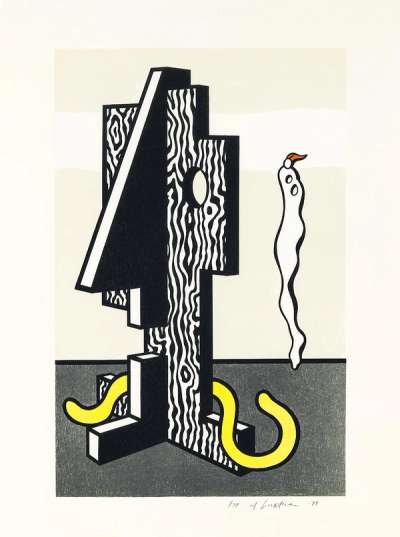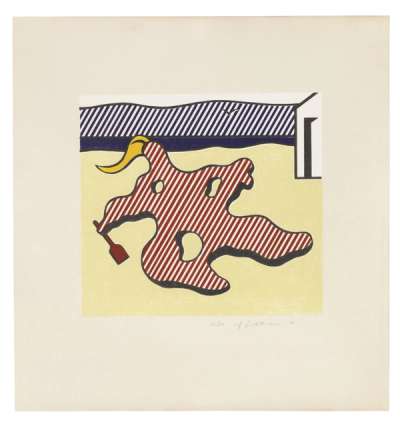Surrealist
series
In the late 1970s, Roy Lichtenstein created his Surrealist series, which sees him recombine his signature elements into dreamscapes. The series collages together his well-known female heroines and landscapes, alongside more abstract sculptural elements, all rendered in his bold, graphic style.
Roy Lichtenstein Surrealist series for sale

£30,000-£45,000
$60,000-$90,000 Value Indicator
$50,000-$80,000 Value Indicator
¥270,000-¥410,000 Value Indicator
€35,000-€50,000 Value Indicator
$290,000-$440,000 Value Indicator
¥5,710,000-¥8,560,000 Value Indicator
$40,000-$60,000 Value Indicator
TradingFloor
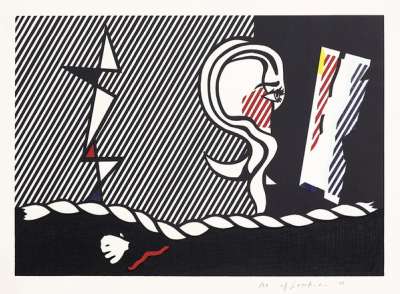
£6,500-£9,500
$12,500-$18,000 Value Indicator
$11,000-$16,000 Value Indicator
¥60,000-¥90,000 Value Indicator
€7,500-€11,000 Value Indicator
$60,000-$90,000 Value Indicator
¥1,230,000-¥1,800,000 Value Indicator
$8,500-$12,000 Value Indicator
TradingFloor
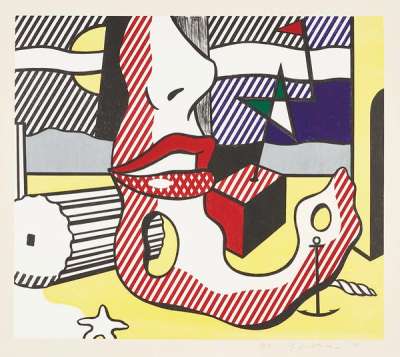
£9,000-£13,000
$17,000-$25,000 Value Indicator
$16,000-$22,000 Value Indicator
¥80,000-¥120,000 Value Indicator
€10,500-€15,000 Value Indicator
$90,000-$130,000 Value Indicator
¥1,710,000-¥2,470,000 Value Indicator
$11,500-$17,000 Value Indicator
TradingFloor
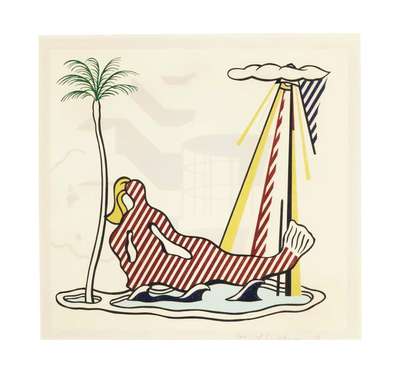
£11,000-£17,000
$21,000-$35,000 Value Indicator
$19,000-$29,000 Value Indicator
¥100,000-¥160,000 Value Indicator
€13,000-€20,000 Value Indicator
$110,000-$170,000 Value Indicator
¥2,090,000-¥3,230,000 Value Indicator
$14,000-$22,000 Value Indicator
TradingFloor
Sell Your Art
with Us
with Us
Join Our Network of Collectors. Buy, Sell and Track Demand
Meaning & Analysis
Lichtenstein’s 1970s Surrealist series pays tribute to multiple modern art historical tropes and genres while maintaining his signature style. His iconic artworks, predominantly inspired by popular culture and mass-production, pursued an ongoing dialogue with the masters of modern painting and classical art.
To this day, a simple mention of Lichtenstein’s name instantly summons his signature patterns, primary colours and enlarged melodramatic comic book figures. Although his creations often have a distinctively polished pop aesthetic, the artist was known for eagerly experimenting with materials and styles.
Lichtenstein often invented and combined pictorial codes, blurring the boundaries between figuration and abstraction. In manufacturing his artworks, he borrowed strategies from various printed archives, while also examining sculptural practices and painterly gestures.
The power of Lichtenstein’s art lies in his critical, yet humorous approach to his subject matter. Venturing beyond Pop Art, his take on the thematic concerns of avant-garde movements is remarkable in his Surrealist Series.
Executed in the late 1970s, the prints in the Surrealist sequence possess a potent visual and conceptual impact. The series pays tribute to the legacies of multiple modern art historical tropes, as well as traditional genres. As such, Lichtenstein condenses the attributes of landscape painting and nude iconography into these frames. Thereafter, he supplements the canvases with a succession of cubist, purist, futurist, essentialist and surrealist icons.
As a result, the Surrealist portraits relay a particular type of formal unity. As their starting point, each print mimics the manner in which original modern, and specifically surrealist, artworks were created. Originating in the 1920s, surrealist artists delved into subconscious realities, stringing together peculiar types of imagery. Lichtenstein’s Surrealist Series follows suit, merging disparate elements into impactful compositions.
However, the pictorial language of the Surrealist sequence is literal rather than symbolical. Unlike the intuitive output of his forerunners, Lichtenstein's Surrealist portraits reveal a rigorously calculated approach. It is evident that the artist explored his structures through multiple detailed sketches first. Furthermore, his application of graphic forms and vibrant colours perpetuates the mechanical vision of printed reproductions. Therefore, this series is in many ways entirely contradictory to the underlying principles of modern art.

